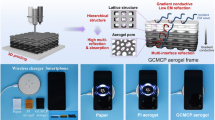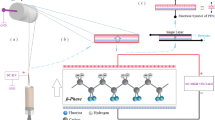Abstract
In this paper closed-form expressions are presented for the current components in a CNT-based p-n junction diode resulting from a multisinusoidal input voltage. The expressions obtained, in terms of the modified Bessel functions, are simple and can be used for calculating the amplitudes of the fundamental, harmonics and intermodulation (mixing) current components in the CNT-based p-n junction diode. Using these expressions the performance of the CNT-based p-n junction diode excited by an equal-amplitude two-tone was studied in detail. The results obtained show that the amplitudes of the harmonic and mixing components are strongly dependent on the DC bias voltage, the series resistance and the ideality factor of the p-n junction diode.




Similar content being viewed by others
References
J. U. Lee, “Photovoltaic effect in ideal carbon nanotube diodes,” Applied Physics Letters 87, 073101/1–3 (2005).
J. U. Lee, P. P. Gipp, and C. M. Heller, “Carbon nanotube p-n junction diode,” Applied Physics Letters 85, 145–147 (2004).
S. M. Sze, Physics of semiconductors (Wiley, New York, 1981).
W. R. Gretsch, “The spectrum of intermodulation generated in a semiconductor diode junction,” Proceedings of the IEEE 54, 1528–1535 (1966).
F. A. Cassara, “A laboratory experiment on communication electronics,” International Journal of Electrical Engineering Education 14, 319–324 (1977).
K. K. Clarke and D. T. Hess, Communication Circuits: Analysis and Design (Addison-Wesley, 1971).
L. M. Orloff, “Intermodulation analysis of crystal mixers,” Proceedings of the IEEE 52, 173–179 (1964).
J. Choma, Jr., Harmonic and intermodulation distortion in current-feedback bipolar transistor amplifiers, Proceedings of the IEE, Part G 128, 264–268 (1981).
E. F. Beane, “Prediction of mixer intermodulation levels as function of local oscillator power,” IEEE Transactions on Electromagnetic Compatibility EMC-13, 56–63 (1971).
R. V. Stewart and J. G. Gardiner, “Contribution to mixer intermodulation distortion of nonlinearity in diode forward characteristics,” Electronics Letters 7, 279–281 (1971).
E. B. Lipkovich, “Calculation of intermodulation component levels in Schottky barrier diode frequency converters,” Telecommunicaton and Radio Engineering 33/34, 99–101 (1979).
Author information
Authors and Affiliations
Corresponding author
Rights and permissions
About this article
Cite this article
Abuelma’atti, M.T. Theoretical Analysis of Carbon-Nanotube-Based Mixers and Frequency Multipliers. J Infrared Milli Terahz Waves 31, 585–592 (2010). https://doi.org/10.1007/s10762-009-9612-5
Received:
Accepted:
Published:
Issue Date:
DOI: https://doi.org/10.1007/s10762-009-9612-5




